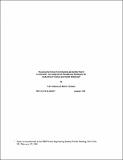Planning for future uncertainties in electric power generation : an analysis of transitional strategies for reduction of carbon and sulfur emissions
Author(s)
Tabors, Richard D.; Monroe, Burt L.
Download28596138.pdf (992.4Kb)
Metadata
Show full item recordAbstract
The object of this paper is to identify strategies for the U.S. electric utility industry for reduction of both acid rain producing and global warming gases. The research used the EPRI Electric Generation Expansion Analysis System (EGEAS) utility optimization/simulation modeling structure and the EPRI developed regional utilities. It focuses on the North East and East Central region of the U.S. Strategies identified were fuel switching -- predominantly between coal and natural gas, mandated emission limits, and a carbon tax. The overall conclusions of the study are that using less (conservation) will always benefit Carbon Emissions but may or may not benefit Acid Rain emissions by the offsetting forces of improved performance of new plant as opposed to reduced overall consumption of final product. Results of the study are highly utility and regional demand specific. The study showed, however, that significant reductions in both acid rain and global warming gas production could be achieved with relatively small increases in the overall cost of production of electricity and that the current dispatch logics available to the utility control rooms were adequate to reschedule dispatch to meet these objectives.
Date issued
1991Publisher
MIT Center for Energy and Environmental Policy Research
Other identifiers
91-001
Series/Report no.
Working paper (Massachusetts Institute of Technology. Center for Energy Policy Research) ; MIT-CEPR 91-001.